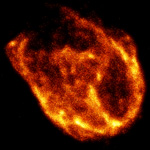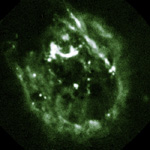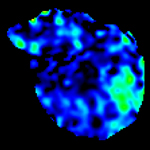CXC Home | Search | Help | Image Use Policy | Latest Images | Privacy | Accessibility | Glossary | Q&A
What Do These Images Tell Us?
X-ray

NASA/CXC/SAO
In the Chandra X-ray image of N132D made with the High Resolution Camera, the regions of brightest X-ray emission are shown in yellow.
The N132D supernova remnant appears to be colliding with a giant molecular
cloud, which produces the brightening on the southern rim of the remnant.
The relatively weak x-radiation on the upper left shows that the shock
wave is expanding into a less dense region on the edge of the molecular
cloud. A number of small circular structures are visible in the central
regions and a hint of a large circular loop can be seen in the upper
part of the remnant. The expanding shock wave has swept up material
equal to that of 600 suns.
Optical

J.Morse/CTIO
The optical image shows gas that has a temperature of a few tens
of thousands of degrees, much lower than the 10 million degree X-ray
emitting gas. The similarity of the two images is striking, but a
detailed examination shows important differences. The optical shell
is not as complete, and some of the clumps in the interior are known
to have high concentrations of the element oxygen. These are believed
to have been ejected in the explosion, which must have occurred about
3,000 years ago.
Radio

J. Dickel and D. Milne, ACTA
The radio emission from N132D is due to "synchrotron radiation"
from high-energy electrons (moving very nearly at the speed of light)
spiraling in the magnetic field of the supernova remnant. The radio
structure traces out regions where there are concentrations of high-energy
electrons and the magnetic field is strong. This is expected to occur
near shock waves, which explains the similarity in appearance between
the radio and X-ray images. However, note that the radio emission
is strong in the X-ray "hole" at the lower right. This could be due
to a bubble of high-energy electrons, or a strong magnetic field region
which has pushed the hot gas away.
Return to N132D (01 Sep 99)


